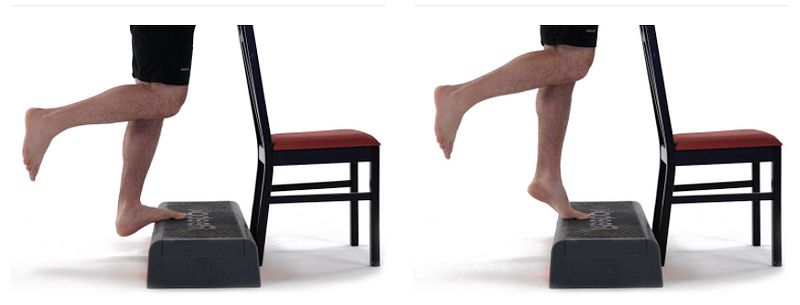A Simple Solution for Tendinitis Relief Without a Doctor Visit
Written on
Understanding Tendinitis
If you've dealt with tendinitis, your instinct may have been to visit a healthcare professional. That’s a sensible approach; after all, injuries typically warrant medical attention. However, what if I told you that you could actively engage in your recovery right now? Even better, it only requires a ten-minute commitment and can help avert future injuries.
Before diving into the solution, let's take a moment to understand what tendinitis entails. This condition manifests as inflammation of a tendon, which can arise from overuse, infections, or rheumatic diseases. Common symptoms include slight swelling, tenderness, and pain, which can escalate if left untreated while continuing daily activities. Typical injury sites include the elbow, shoulder, wrist, knee, and Achilles tendon, with terms like tennis elbow or golfer’s elbow referring to specific forms of tendinitis.
Focusing on Overuse Tendinitis
In this discussion, I will primarily address the overuse aspect of tendinitis. These injuries often stem from mechanical stressors that cause compensatory behaviors, repetitive occupational tasks, or a variety of sports, including baseball, basketball, golf, tennis, and running.
One of the most frustrating aspects of tendinitis is its gradual onset, which can significantly hinder your ability to engage in activities you enjoy. Personally, I faced a challenging battle with bicep tendinitis that sidelined me from the gym for several months. It wasn’t until I received education from a skilled physical therapist that I began to see signs of recovery. Regrettably, I could have returned to my regular activities much sooner if I had known more about effective tendinitis rehabilitation.
Getting Active in Your Recovery
Don't make the same mistake I did by simply resting your joints and hoping for improvement. You can start actively participating in your recovery and preventing further issues today!
The Mechanics of Tendinitis
Before we delve into the specifics, a quick disclaimer: everyone's experience is unique. I’m not suggesting that this method will resolve all issues magically. Instead, this exercise can help strengthen your tissues and provide relief (when practiced consistently) for most individuals. If you’re ever uncertain about your situation, please consult a healthcare professional.
Now, onto the useful information!
Challenging an injured tendon through resistance training is crucial to understanding the mechanics of tendinitis. The condition arises when the forces applied exceed the strength capacity of your tissue, making overuse a significant risk factor. This imbalance can lead to the tendon experiencing wear and tear, causing pain and discomfort.
“What we need to be looking at is reducing the force and stress placed upon the joint while also doing what we can to improve the resilience or capacity of that tissue.” — Coach Eugene Teo
My previous approach of resting and recovering wasn’t effective because, while I reduced the applied force by avoiding the gym, I neglected to address the strength imbalance. Consequently, every time I attempted to return to my routine, the pain would resurface. My tendons remained stiff, vulnerable, and susceptible to injury regardless of how much I rested.
I was trapped in a frustrating cycle simply because I didn’t tackle the underlying issue.
Effective rehabilitation for tendinitis injuries necessitates directly challenging your tissues. As with most physical injuries, we must adopt an active stance to achieve results. This means adjusting our strength training routines to support our joints and tissues in a way that facilitates healing.
10 Minutes for Tendon Pain Relief
Fortunately, it has been established that tendons, like other fibrous connective tissues, can adapt to the stresses placed on them. When appropriate stress is consistently applied, exercise promotes collagen deposition, leading to healthier, more resilient tissues.
Research indicates that one of the most effective strategies for enhancing tendon health is to perform short, lighter weight resistance exercises for ten minutes at intervals of six hours. Ideally, someone recently injured should initiate training as soon as possible, aiming for three brief sessions throughout the day.
Each session should focus on the injured site to maximize recovery and hasten your return to everyday activities. The rationale behind these brief, spaced-out sessions is that tendons can quickly become unresponsive to exercise stimuli. After ten minutes of work, the molecular response in your tendon peaks, and it will take around six hours to become responsive to exercise again.
Knowing this, we can formulate a rapid and effective rehabilitation program for your tendon injury. Here’s a structured plan:
- 3–4 minutes of warm-up: Activities like jogging, jumping jacks, or quick feet exercises to elevate your heart rate and activate your nervous system.
- 2–3 joint-specific mobility exercises (10–15 reps): This phase allows you to work on your range of motion without added load. Focus on slow, controlled movements to enhance stability. Some favorite exercises include hip CARS, shoulder CARS, knee CARS, ankle circles, and elbow circles. Only perform movements that challenge the injured area without causing pain.
- 2–3 rounds of isometric holds (1–2 minutes each): If you’re pressed for time, this is the ‘quick trick’ to implement. An isometric hold involves muscle contraction without length alteration, allowing you to rehabilitate the tissues without the discomfort associated with full-range loading. Although holding for extended periods can be tedious, the benefits are well worth it! Here are examples targeting commonly injured areas:
Isometric External Rotation (shoulder)

Isometric Elbow Flexion (can also be done with dumbbells)

Isometric Single-Leg Calf Raise (Achilles)

Full range of motion exercises should be reintroduced once they become tolerable. Everyone progresses at their own pace, so feel free to adjust these exercises to suit your needs. Additionally, don’t overlook factors like sleep, nutrition, stress management, and occupational health. This isometric approach is a validated method to initiate your recovery, but you will only optimize it by building a supportive lifestyle.
In Conclusion
There's a lot you can do to rehabilitate and fortify your tendons without relying on prescription medications or expensive supplements. Moreover, the process is remarkably quick and straightforward! Just a few ten-minute physical therapy sessions can set you on the road to recovery. The best part is that you have complete control over this process. The mobility and strength exercises mentioned can be performed virtually anywhere, requiring minimal or no equipment—no gym or clinic necessary!
Whether you're recovering from tendinitis or feeling perfectly healthy, I encourage you to incorporate tendon-strengthening exercises into your weekly schedule. By intentionally placing new stresses on your musculoskeletal system, you'll cultivate resilience that can help prevent future injuries. Dedicate a few minutes each day, and you can begin transforming your tissues into something stronger than ever!
-David Liira, Kin

Chapter 2: Video Guides for Tendinitis Management
Learn how to relieve Achilles tendonitis quickly with effective exercises in this video.
Discover eight simple moves to fix Achilles tendonitis in this comprehensive guide.